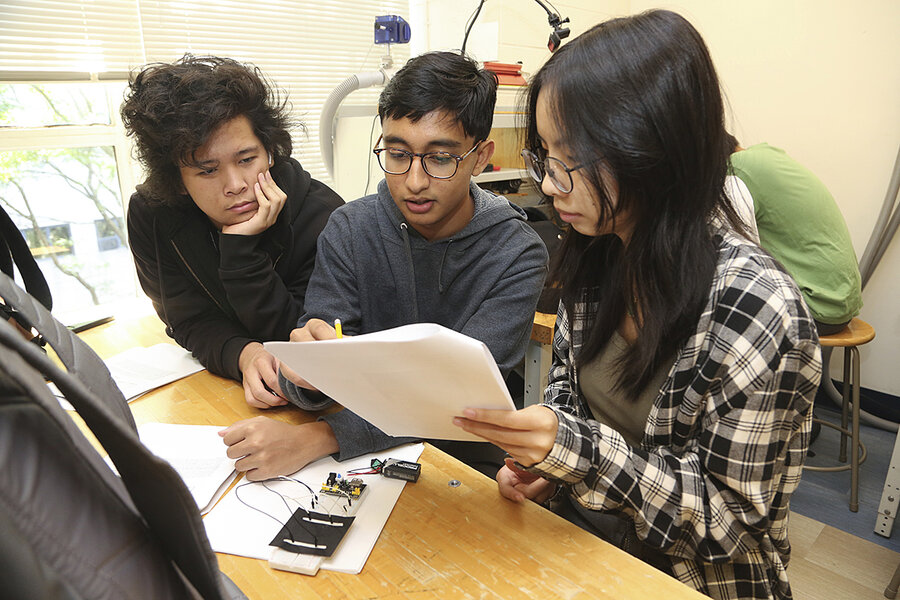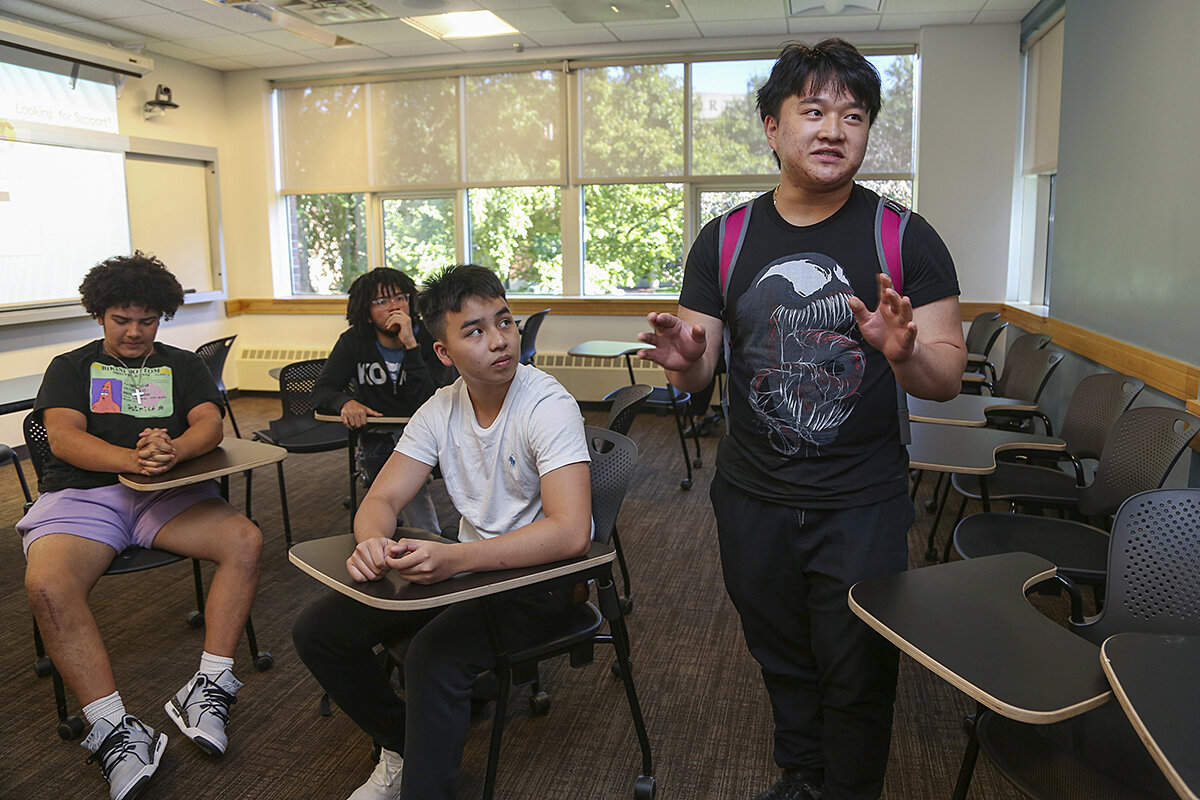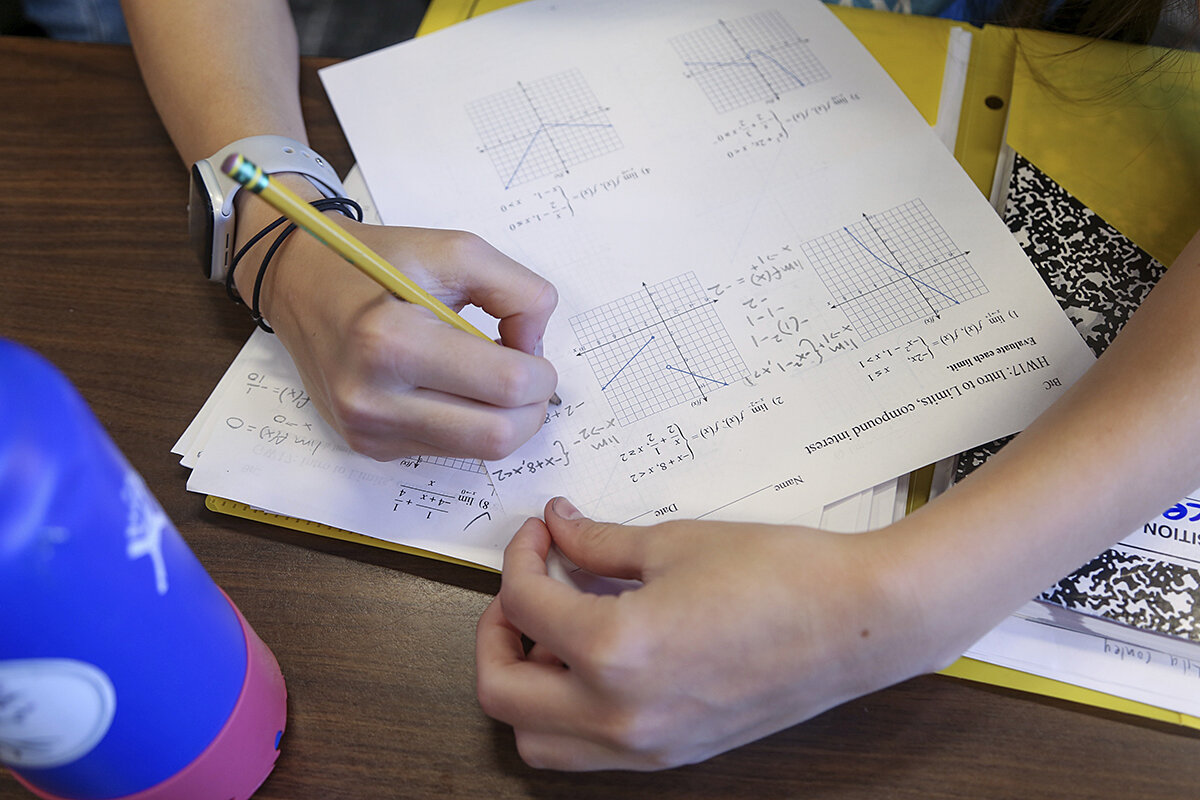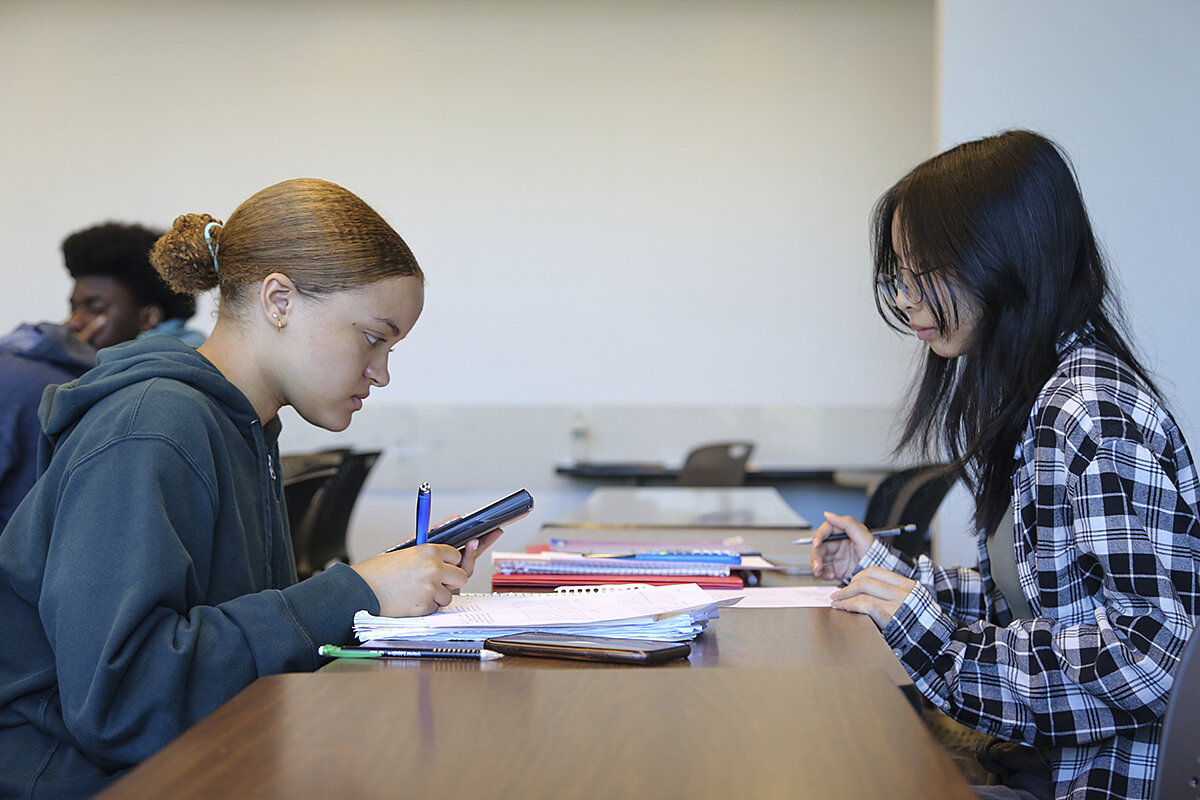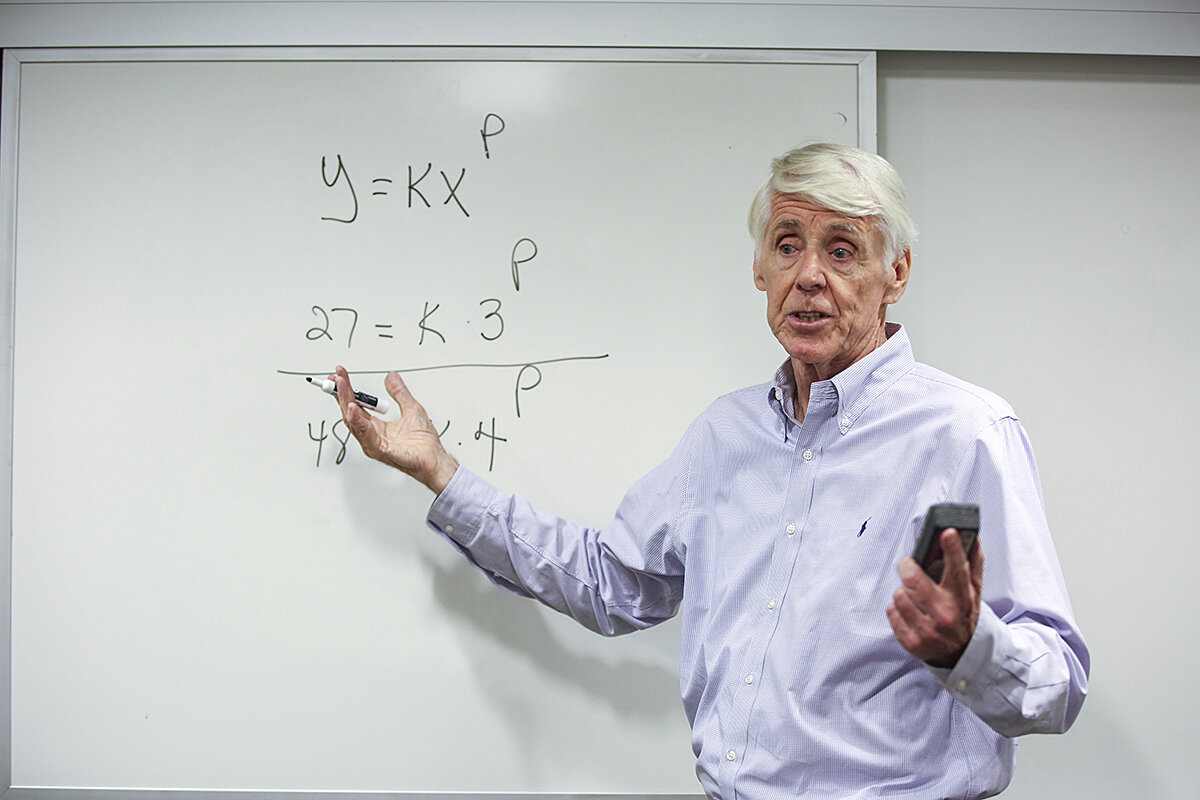Math lovers wanted: The US needs more in order to thrive
Loading...
| Boston
Like a lot of high school students, Kevin Tran loves superheroes, though perhaps for different reasons than his classmates.
“They’re all insanely smart. In their regular jobs they’re engineers, they’re scientists,” says Mr. Tran, who is 17. “And you can’t do any of those things without math.”
Mr. Tran also loves math. He is speaking during a break in a city program for promising local high school students to study calculus for five hours a day throughout the summer at Northeastern University in Boston. And his observation is surprisingly apt.
Why We Wrote This
Math scores may feel distant from most people’s lives. But a U.S. math deficit raises questions about how the country plans to protect its economic competitiveness and national security. This story is part of The Math Problem, the latest project from the newsrooms of the Education Reporting Collaborative.
At a time when Americans joke about how bad they are at math, and already abysmal scores on standardized math tests are falling even further, employers and others say the United States needs people who are good at math in the same way motion picture mortals need superheroes.
They say America’s poor math performance isn’t funny anymore. It’s a threat to the nation’s global economic competitiveness and national security.
“The advances in technology that are going to drive where the world goes in the next 50 years are going to come from other countries, because they have the intellectual capital and we don’t,” says Jim Stigler, a psychology professor at the University of California, Los Angeles, who studies the process of teaching and learning subjects including math.
There’s already ample and dramatic evidence of this.
World challenges require math
Several largely overlooked reports, including from the Department of Defense, raise alarms about how Americans’ disdain for math is a threat to national security.
One, issued in July by the think tank The Aspen Institute, warns that international adversaries are challenging America’s longtime technological dominance. “We are no longer keeping pace with other countries, particularly China,” it says, calling this a “dangerous” failure and urging decisionmakers to make education a national security priority.
“There are major national and international challenges that will require better math skills,” says Josh Wyner, vice president of The Aspen Institute and founder and executive director of its College Excellence Program.
“This is not an educational question alone,” says Mr. Wyner. “It’s about knowledge development, environmental protection, better cures for diseases. Resolving the fundamental challenges facing our time require math.”
The Defense Department, in a separate study, calls for an initiative akin to the 1958 Eisenhower National Defense Act to support education in science, technology, engineering, and math, or STEM. It reports that there are now eight times as many college graduates in these disciplines in China and four times as many engineers in Russia than in the United States. China has also surpassed the United States in the number of doctoral degrees in engineering, according to the National Science Foundation.
Meanwhile, the number of jobs in math occupations – which “use arithmetic and apply advanced techniques to make calculations, analyze data, and solve problems” – will have increased by 29% in the 10 years ending in 2031, or by more than 30,000 per year, Bureau of Labor Statistics figures show. That’s much faster than most other kinds of jobs.
“Mathematics is becoming more and more a part of almost every career,” says Michael Allen, who chairs the math department at Tennessee Technological University.
Tennessee Tech runs a summer camp teaching cybersecurity, which requires math, to high school students. “That lightbulb goes off and they say, ‘That’s why I need to know that,’” Professor Allen says.
There are deep shortages of workers in information technology fields, according to the labor market analytics firm Lightcast, which says that there were more than 4 million job postings over the last year in the United States for software developers, database administrators and computer user support specialists.
With billions being spent to beef up U.S. production of semiconductors, Deloitte reports a projected shortage in that industry, too, of from 70,000 to 90,000 workers over the next few years.
All of these careers require math. Yet math scores among American students — which had been stagnant for more than a decade, according to the National Science Foundation — are now getting worse.
Math performance among elementary and middle-school students has fallen by 6% to 15% below pre-pandemic growth rates, depending on the students’ age, since before the pandemic, according to the Northwest Evaluation Association, which administers standardized tests nationwide. Math scores on the National Assessment of Educational Progress fell by 9 points last year, the largest drop ever recorded, to their lowest levels in more than three decades.
In the most recent Program for International Student Assessment tests in math, or PISA, U.S. students scored lower than their counterparts in 36 other education systems worldwide. Students in China scored the highest.
Math = economic growth
Even before the pandemic, only 1 in 5 college-bound American high school students was prepared for college-level courses in STEM, according to the National Science and Technology Council. Among the students who decide to study STEM in college, more than a third end up changing their majors, according to the U.S. Department of Education.
“And these are the students who have done well in maths,” says Jo Boaler, a British author who studies the teaching of math as a professor at the Stanford University Graduate School of Education. “That’s a huge loss for the U.S.”
One result of this exodus is that, in the fast-growing field of artificial intelligence, two-thirds of U.S. university graduate students and more than half the U.S. workforce in artificial intelligence and AI-related fields are foreign born, according to the Georgetown University Center for Security and Emerging Technology.
Only around 1 in 5 graduate students in math-intensive subjects including computer science and electrical engineering at U.S. universities are American, the National Foundation for American Policy reports, and the rest come from abroad. Most will leave when they finish their programs; many are being aggressively recruited by other countries, such as Canada and the United Kingdom.
The economic ramifications of this in the United States are twofold: first, on individuals’ job prospects and earnings potential; and second, on the country’s productivity and competitiveness.
Every one of the 25 highest-paying college majors are in STEM fields, the financial advising website Bankrate found.
Ten years after graduating, math majors out-earn graduates in other fields by about 17%, according to an analysis by the Burning Glass Institute using the education and job histories of more than 50 million workers. That premium would be even higher if it wasn’t for the fact that 16% of math majors become teachers.
Knowing math “is a huge part of how successful people are in their lives and what jobs are open to them, what promotions they can get,” Professor Boaler says.
A Stanford economist has estimated that, if U.S. pandemic math declines are not reversed, students now in kindergarten through grade 12 will earn from 2% to 9% less over their careers – depending on what state they live in – than their predecessors educated just before the start of the pandemic. The states themselves will suffer a decline in gross domestic product of from 0.6% to 2.9% per year, or a collective $28 trillion over the remainder of this century.
Countries whose students scored higher on math tests have experienced greater economic growth than countries whose students tested lower, one study found. It calculated that had the U.S. improved its math scores on the PISA test as promised by President George H. W. Bush and the nation’s governors in 1989, it would have resulted in a 4.5% bump in the U.S. gross domestic product by 2015. That increase did not occur.
“Math matters to economic growth for our country,” says Mr. Wyner, of The Aspen Institute.
This is among the reasons that it isn’t only schools that have been pushing for more students to learn math. It’s economic development agencies such as the Michigan Economic Development Corporation, which is trying to get more students into STEM so they can fill jobs in fields such as semiconductor production and electric vehicle design, in which the state projects a need for up to 300,000 workers by 2030.
“Math just underpins everything,” says Megan Schrauben, executive director of the Michigan Department of Labor and Economic Opportunity’s MiSTEM initiative to improve STEM education. “It’s extremely important for the future prosperity of our students and communities, but also our entire state.”
Getting young people on board
The top reason young people ages 13 to 18 say they wouldn’t consider a career in technology is that it requires math and science skills, a survey by the information technology industry association and certification provider CompTIA finds. Forty-six percent fear they aren’t good enough in math and science to work in tech, a higher proportion than their counterparts in Australia, Belgium, India, the Middle East and the U.K.
In Massachusetts, which is particularly dependent on technology industries, employers are anticipating a shortage over the next five years of 11,000 workers in the life sciences alone.
“It’s not a small problem,” says Edward Lambert Jr., executive director of the Massachusetts Business Alliance for Education. “We’re just not starting students, particularly students of color and from lower-resourced families, on career paths related to math and computer science and those things in which we need to stay competitive, or starting them early enough.”
The Bridge to Calculus program at Northeastern, where Mr. Tran spent his summer, is a response to that. The 113 participating students were paid $15 an hour, most of it from the city and its public schools, the program’s coordinator, Bindu Veetel, says; the university provided the classroom space and some of the teachers.
The students’ days began at 7:30 a.m., when teacher Jeremy Howland roused his sleepy-looking charges by having them run exercises in their heads, such as calculating 20% of various figures he’d written on the whiteboard.
He wasn’t doing it to show them how to leave a tip. He wanted them to explain their thought processes.
“I can see the wheels turning in your head,” Mr. Howland told the sea of faces in front of him one early morning as knees bobbed and pens drummed on pages of paper notebooks crowded with equations.
The students’ daily two-hour daily calculus class got only tougher after that. Slowly the numbers yielded their secrets, like a mystery being solved. One of the students even corrected the teacher.
“Bada-bing,” Mr. Howland said whenever they were right. “OK, now you’re talking math.”
Students used some of the rest of their time learning how to apply that knowledge, trying their hands at coding, data analysis, robotics, and elementary electrical engineering under the watchful supervision of mentors including previous graduates of the program.
“We show them how this leads to a career,” says Ms. Veetel, who says the program’s alumni have gone on to software, electrical and civil engineering, math research, teaching, medical, and other careers. “They have so many options with math. Slowly that spark comes on, that this is something they can do.”
“Who wouldn’t like math?”
It’s not just a good deed that Northeastern is doing. Some of the graduates of Bridge to Calculus end up enrolling there and proceeding to its highly ranked computer science and engineering programs, which – like those at other U.S. universities – struggle to attract homegrown talent.
More than half of the graduate students in all disciplines at Northeastern, including those that require math, are foreign born, university statistics show. In his field of engineering management, “80% of us are Indian,” Suuraj Narayanan Raghunathan, a graduate student serving as a Bridge to Calculus mentor, says with a laugh.
The American high school students say they get why their classmates don’t like math.
“It’s a struggle. It’s constant thinking,” says one, Steven Ramos, 16, who says he plans to become a computer or electrical engineer instead of following his brother and other relatives into construction work.
But with time, the answers come into focus, says Wintana Tewolde, also 16, who wants to be a doctor. “It’s not easy to understand, but once you do, you see it.”
Peter St. Louis-Severe, 17, says math, to him, is fun. “It’s the only subject I can truly understand, because most of the time it has only one answer,” says Mr. St. Louis-Severe, who hopes to be a mechanical or chemical engineer and whose gamer name is Mathematics Boss. “Who wouldn’t like math?”
Not everyone is convinced that a lack of math skills is holding America back.
“We push so many kids away from computer science when we tell them you have to be good at math to do computer science, which isn’t true at all,” says Todd Thibodeaux, president and CEO of CompTIA.
What employers really want, Mr. Thibodeaux says, “is trainability, the aptitude of people being able to learn the systems and solve problems.” Other countries, he says, “are dying for the way our kids learn creativity.”
Back in their classroom at Northeastern, students spent a brief break exchanging math jokes, then returned to class, where even Mr. Howland’s hardest questions generally failed to stump them.
They confidently answered as he grilled them on polynomial functions. And after an occasional stumble, they got all the exercises right.
“Bada-bing,” their teacher happily responded.
Editor's note: This story has been updated to correct what the acronym STEM stands for.
This piece is part of The Math Problem, an ongoing series documenting challenges and highlighting progress, from the Education Reporting Collaborative, a coalition of eight diverse newsrooms: AL.com, The Associated Press, The Christian Science Monitor, The Dallas Morning News, The Hechinger Report, Idaho Education News, The Post and Courier in South Carolina, and The Seattle Times. To read more of the collaborative’s work, visit its website.




